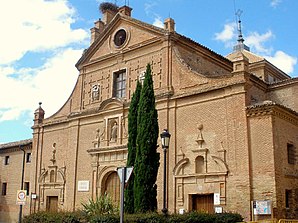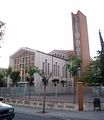Corella (Navarre)
| Corella municipality | ||
|---|---|---|
 Corella - Iglesia del Convento de la Encarnacion
|
||
| coat of arms | Map of Spain | |

|
|
|
| Basic data | ||
| Autonomous Community : |
|
|
| Province : | Navarre | |
| Comarca : | Tudela | |
| Coordinates | 42 ° 7 ′ N , 1 ° 47 ′ W | |
| Height : | 370 msnm | |
| Area : | 81.35 km² | |
| Residents : | 7,971 (Jan 1, 2019) | |
| Population density : | 97.98 inhabitants / km² | |
| Postal code : | 31591 | |
| Municipality number ( INE ): | 31077 | |
| administration | ||
| Website : | Corella | |
Corella is a small town and municipality ( municipio ) with a total of 7,971 inhabitants (January 1, 2019) in the extreme southwest of the autonomous community of Navarre in Spain .
Location and climate
The place Corella is located on the east bank of the Río Alhama approx. 18 km (driving distance) northwest of the city of Tudela at an altitude of approx. 370 m . The climate is temperate to warm; Rain (approx. 525 mm / year) falls mainly in the winter half-year.
Population development
| year | 1857 | 1900 | 1950 | 2000 | 2018 |
| Residents | 5,026 | 6,793 | 5,445 | 6,820 | 7,707 |
Because of the rural exodus as a result of the mechanization of agriculture , the abandonment of small farms and the resulting lower demand for labor in rural areas, the population of the small town has increased significantly since the middle of the 19th century.
economy
Corella was and still is the center of an agricultural region. About a third of the community area is used for agriculture (olives, wine, asparagus, grain, etc.). In the second half of the 20th century, smaller industrial companies (furniture, canning, etc.) emerged and the service sector also developed.
history
The Celts or Celtiberians , Romans , Visigoths and even the Moors - apart from the small building of the so-called Mausoleo de la Torrecilla - left no traces on the area of the municipality and there are no archaeological sources even for the Middle Ages. From written sources it is known, however, that the Ebro Valley was dominated by the Moors in the 10th and 11th centuries, although the Christians formed the majority of the population. In 1119 Alfonso I of Aragón conquered the region and nine years later he gave the place and the castle of Corella as a gift to one of his followers. From the 12th to the 14th centuries, the area was disputed between the kingdoms of Castile , Navarre and Aragón . In 1417, Corella received from Charles III. of Navarre the privilege of holding an annual September market (feria) lasting several days , which Charles V confirmed again in 1524 and was even extended by two days. In the 18th century, the place experienced its economic and cultural heyday.
Attractions
- Churches
- The two-towered Iglesia de San Miguel , built in the first quarter of the 18th century, is dedicated to the Archangel Michael . The interior of the church has only one nave, but has deep side chapels ; it radiates an enormous shine, because the vaults and other components, especially the apse with its opulent late-baroque altarpiece (retablo) , are gilded and / or painted. The eight-sided crossing dome is surrounded by figures of angels .
- The Iglesia de Nuestra Señora del Rosario is particularly interesting because of its bell tower (campanario) , built entirely from bricks , which transitions from a quadrangular floor plan to octagonal structures and combines both mudéjare (diamond motifs, overlapping arches) and baroque (corner turrets) style elements . The three-aisled interior of the church already presents classical forms. However, the main altar is designed in the late Baroque style of Churriguerism .
- The classicistic church facade of the former Benedictine convent is - with the exception of two stucco coats of arms and a figure of St. Benedict - built entirely from bricks. Since 1973 there has been a museum of sacred art in the church.
- The Convento de Nuestra Señora del Carmen and the Convento de Nuestra Señora de Araceli should also be mentioned .
- The Ermita de Nuestra Señora del Villar shows clear Mudejar style techniques and a similar architectural aesthetic; only the classicist facade made entirely of bricks differs from it.
- City palaces
Corella has several representative city palaces from the 18th and 19th centuries.
- Others
- The small multi-apse of the Mausoleo de la Torrecilla , discovered about 3 km outside of the village, dates from late Roman times , but its actual purpose (possibly a bath) remains unclear.
- From the former castle (castillo) of the place only a wall remains.
Web links
Individual evidence
- ↑ Cifras oficiales de población resultantes de la revisión del Padrón municipal a 1 de enero . Population statistics from the Instituto Nacional de Estadística (population update).
- ^ Corella - population development
- ^ Corella story
- ^ Corella Museum
- ^ Corella - castle ruins













